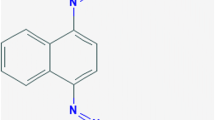Abstract
The 16S rRNA sequence analysis and biochemical characteristics were confirmed that the isolated bacterium is Pseudomonas sp. LBC1. The commonly used textile dye, Direct Brown MR has been used to study the fate of biodegradation. Pseudomonas sp. LBC1 showed 90% decolorization of Direct Brown MR (100 mg/L) and textile industry effluent with significant reduction in COD and BOD. The optimum condition for decolorization was 7.0 pH and 40°C. Significant increase in a activity of extracellular laccase suggested their possible involvement in decolorization of Direct Brown MR. Biodegradation metabolites viz. 3,6-dihydroxy benzoic acid, 2-hydroxy-7-aminonaphthol-3-sulfonic acid, and p-dihydroperoxybenzene were identified on the basis of mass spectra and using the 1.10 beta Shimadzu NIST GC–MS library. The Direct Brown MR and textile industry effluent were toxic to Sorghum bicolor and Vigna radiata plants as compared to metabolites obtained after decolorization. The Pseudomonas sp. LBC1 could be useful strain for decolorization and detoxification of textile dyes as well as textile industry effluent.


Similar content being viewed by others
References
APHA–AWWA–WEF, (2005) Standard methods for the examination of water and wastewater, 21st edn. American Public Health Association, Washington, DC
Chen H, Hopper S, Cerniglia C (2005) Biochemical and molecular characterization of an azoreductase from Staphylococcus aureus, a tetrameric NADPH-dependent flavoprotein. Microbiology 151:1433–1441
Cheng M, Song W, Ma W, Chen C, Zhao J, Lin J, Zhu H (2008) Catalytic activity of iron species in layered clays for photodegradation of organic dyes under visible irradiation. Appl Catal B Environ 77:355–363
Chivukula M, Renganathan V (1995) Phenolic azo dye oxidation by laccase from Pyricularia oryzae. Appl Environ Microbiol 61:4374–4377
Felsenstein J (1985) Confidence limits on phylogenies: an approach using the bootstrap. Evolution 39:783–791
Jadhav J, Kalyani D, Telke A, Phugare S, Govindwar S (2010) Evaluation of the efficacy of a bacterial consortium for the removal of color, reduction of heavy metals, and toxicity from textile dye effluent. Bioresour Technol 101:165–173
Kalme S, Parshetti G, Jadhav S, Govindwar S (2007) Biodegradation of benzidine based dye direct blue-6 by Pseudomonas desmolyticum NCIM 2112. Bioresour Technol 98:1405–1410
Kalyani D, Telke A, Dhanve R, Jadhav J (2009) Ecofriendly biodegradation and detoxification of Reactive Red 2 textile dye by newly isolated Pseudomonas sp. SUK1. J Hazard Mater 163:735–742
Mathur N, Bhatnagar P, Bakre P (2006) Assessing mutagencity of textile dyes from Pali (Rajasthan) using ames bioassay. Appl Ecol Environ Res 4:111–118
Mazmanci M, Unyayar A, Ekiz H (2002) Decolorization of methylene blue by white rot fungus Coriolus versicolor. Fresenius Environ Bull 11:1–5
Minero C, Pellizzari P, Maurino V, Pelizzetti E, Vione D (2008) Enhancement of dye sonochemical degradation by some inorganic anions present in natural waters. Appl Catal B Environ 77:308–316
Nerud F, Baldrian P, Gabriel J, Ogbeifun D (2001) Decolorization of synthetic dyes by the Fenton reagent and the Cu/pyridine/H2O2 system. Chemosphere 44:957–961
Ola I, Akintokun A, Akpan I, Omomowo I, Areo O (2010) Aerobic decolorization of two reactive azo dyes under varying carbon and nitrogen source by Bacillus cereus. Afr J Biotechnol 9:672–677
Pandey A, Singh P, Iyengar L (2007) Bacterial decolorization and degradation of azo dyes. Int Biodeter Biodegr 59:73–84
Parshetti G, Telke A, Kalyani D, Govindwar S (2010) Decolorization and detoxification of sulfonated azo dye methyl orange by Kocuria rosea MTCC 1532. J Hazard Mater 176:503–506
Saitou N, Nei M (1987) The neighbor-joining method: a new method for reconstructing phylogenetic trees. Mol Biol Evol 4:406–425
Salokhe M, Govindwar S (1999) Effect of carbon source on the biotransformation enzymes in Serratia marcescens. World J Microbiol Biotechnol 15:229–232
Sharma S, Singh P, Swami R, Sharma K (2009) Exploring fish bioassay of textile dye wastewaters and their selected constituents in terms of mortality and erythrocyte disorders. Bull Environ Contam Toxicol 83:29–34
Submuth R, Ebersplcher J, Haag R, Springer W (1987) Biochemisch-mikrobiologisches Praktikum. Thieme, Stuttgart & New York
Takezaki N, Rzhetsky A, Nei M (2004) Phylogenetic test of the molecular clock and linearized trees. Mol Biol Evol 12:823–833
Tamura K, Nei M, Kumar S (2004) Prospects for inferring very large phylogenies by using the neighbor-joining method. Proc Natl Acad Sci 101:1034–11035
Tamura K, Dudley J, Nei M, Kumar S (2007) MEGA4: Molecular Evolutionary Genetics Analysis (MEGA) software version 4.0. Mol Biol Evol 24:598–599
Telke A, Joshi S, Jadhav S, Tamboli D, Govindwar S (2010) Decolorization and detoxification of Congo red and textile industry effluent by an isolated bacterium Pseudomonas sp. SU-EBT. Biodegradation 21:283–296
Telke A, Ghodake G, Kalyani D, Dhanve R, Govindwar S (2011) Biochemical characteristics of a textile dye degrading extracellular laccase from a Bacillus sp. ADR. Bioresour Technol 102:1752–1756
Tien M, Kirk T (1983) Lignin-degrading enzyme from the hymenomycete Phanerochaete Chrysosporium burds. Science 221:661–663
Acknowledgement
One of the authors (Dr. Amar A. Telke) is thankful to BK21 program of South Korea for financial assistance.
Author information
Authors and Affiliations
Corresponding author
Electronic supplementary material
Below is the link to the electronic supplementary material.
Table S1
(DOC 53 kb)
Rights and permissions
About this article
Cite this article
Telke, A.A., Kim, SW. & Govindwar, S.P. Significant reduction in toxicity, BOD, and COD of textile dyes and textile industry effluent by a novel bacterium Pseudomonas sp. LBC1. Folia Microbiol 57, 115–122 (2012). https://doi.org/10.1007/s12223-012-0103-z
Received:
Accepted:
Published:
Issue Date:
DOI: https://doi.org/10.1007/s12223-012-0103-z




